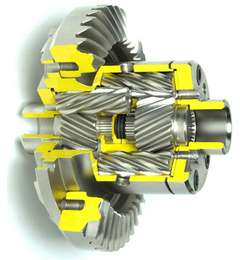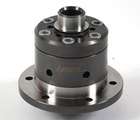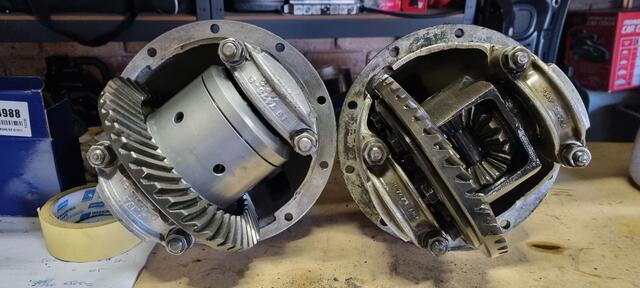The MGA With An Attitude
Limited Slip Differential (LSD) - QUAIFE - RA-302C

 The Quaife ATB Helical LSD differential is a "different beast" so to speak. It uses all gear design for ultimately smooth transfer of torque to the proper places. This is not to say it does not use friction, just no fixed torque clutch or brake plates.
The Quaife ATB Helical LSD differential is a "different beast" so to speak. It uses all gear design for ultimately smooth transfer of torque to the proper places. This is not to say it does not use friction, just no fixed torque clutch or brake plates.
The essence of this design is high angle helical gears. When both wheels have equal traction the differential works in normal fashion. This is a torque sensing differential rather than speed sensing. As such it does not try to make the inside wheel turn same speed as the outside wheel. As long as both wheels have traction it transmits equal torque to both wheels regardless of relative wheel speed, very similar to an open differential. One nice feature here is very little affect on understeer or over steer with throttle changes.
When one wheel starts to slip the helical gears slide endwise with a force proportional to the torque on the wheels (not fixed torque and not proportional to speed). This applies a load on a sidewall friction plate to generate resistance to bias the output torque accordingly. This is in effect applying a braking force to the wheel that has less traction, but the reaction force is transferred to drive the other side rather than energy being lost as friction heat. Changing angle of the helical teeth changes the limit of torque bias. These can be designed with torque bias of 3:1 or up to 5:1. So if one wheel begins to lose traction the other wheel can receive up to 5 times as much torque as the one that is slipping. It also has the advantage of being able to transmit nearly all of the propshaft input torque to the wheels, proportioning torque appropriately up to the point where both wheels might spin at the same time.
Unfortunately five times zero is still zero, so when one wheel hits a patch of wet ice it will still spin, and the other wheel will be limited to five times the torque as the one on ice. This works well as long as the low torque wheel still has some grip and some available torque, but if you lift a wheel in a fast turn it will immediately revert to zero torque all around like an open differential. As such, this works best with well tuned suspension that can keep the drive wheels planted on the pavement. If you happen to be aware of the total loss of traction when it happens, and you understand how these things work, you can step gently on the brakes to stop spinning of the unloaded wheel. This will then apply up to five times as much torque as the light braking effect to the wheel that is not spinning, which will in turn overcome the light braking force and push the vehicle. Competition drivers may soon develop the technique of "left foot braking" while they keep the right foot on the throttle. (Incidentally this torque sensing differential works quite well in conjunction with a modern anti lock braking system).
Another significant advantage of the Quaife design is that the all gear unit will have very little wear, so it is maintenance free and comes with a lifetime warranty. They are relatively expensive to purchase, but value may come with the results. You can buy these off the shelf for installation in your MGA or early MGB banjo style rear axle. Just specify the number of splines required in the sun gears to match the splines on your half shafts.
(Click for Quaife web page).
Addendum, October 10, 2023:
I have a report of a new Quaife differential not fitting into the MGA banjo axle housing.
On Oct 10, 2023 Michael Ellsmore in Vermont South, Vic, Australia wrote:
"A friend has had trouble fitting a 3.9 diff assembly fitted with a Quaife LSD center to his 1500 MGA banjo diff housing. It won't go the last 1/4 inch. The 4.3 diff assembly fitted with a standard center goes in no problem. It appears it is hitting on the protrusion (oil scraper?) at the top of the diff housing. Has anyone else had this issue? Is the protrusion standard on all MGA/MGB banjo diff housings? I cannot recall seeing it on my MGA that has a Quaife center fitted".

"Inside the MGA Diff housing - what does this do"? -- Greg

Notice the notch in the front flange at top of picture. That is clearance for the ring gear to pass when the differential is installed. The sheet metal baffles fit close in proximity to the ring gear. When the car is in forward motion, the ring gear throws a LOT oil onto the open baffle. Oil is then directed by gravity to flow outboard left and right above the baffles, following the baffles into the outboard housing tubes, all the way to the axle outboard ends, where it flows into the rotating hubs to oil the wheel bearings.
When the hubs get 1/3 full of oil, excess oil flows back into the the axle housing, where it flows by gravity back to the "sump" space in the differential housing.
If you have 15 minutes to spare, see video here:
https://www.autoweek.com/car-life/but-wait-theres-more/a36076511/oil-inside-your-diff/
Skip to 5:20 to watch the oil circulate for 3 minutes.
If you want to see how oil flows outboard, you can leave the halfshafts out of your rear axle and run the drive train. But do have catch pans in place under the hubs to catch out flowing oil.
"The prompt for my question was that this part seems to be fouling my installation of a borrowed 3.9 (Quaife). -- Is it 'normal' to take the baffle out when fitting a Quaife? -- Would there be no issue with a standard MGB 3.9 banjo diff"? -- Greg
You need to determine the point of interference. Maybe not as simple as the brake pipe caught behind the flange, or some undersize hole caught on the neck of one of the threaded studs.
Insert the diff as far as it will go, then turn the input flange to get it to rotate a bit. If it drags, then the rotating parts are interfering. That should leave a visible scratch mark somewhere. If it doesn't drag, then some fixed part has interference.
The center hub of the Quaife is rather fat. If that is touching the baffle bottom edge, it could be a simple as grinding a smidge off the edge of the baffle. If the ring gear is dragging on the cupped part of the baffle, then I dunno. Maybe depends on where and how much interference.
MGA and MGB banjo axles are supposed to be identical, except for the bolt-on brake parts, size of the wheel studs, and position of the hand brake cable bracket. The 3.9 diff ratio was an option on the MGA when new, even has a speedometer model number for it. I have a MGB 3.9 diff in my MGA since turn of the century, no problem.
Maybe you need to contact the Quaife people with this issue, and ask them for installation instructions. If it doesn't physically fit, and they can't tell you how to make it work, they shouldn't be selling the part.
|